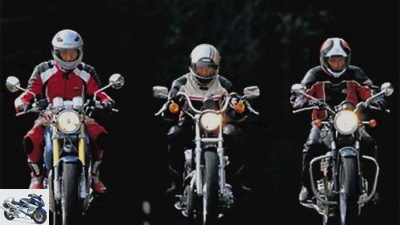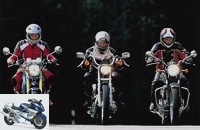Menus

duke
Roadster comparison
Country love
There was a time when a motorcycle could just be a motorcycle. Far from all class constraints, without any pressure to perform. Three manufacturers remember it and invite you to the country tour.
Driving, experiencing, being on the road? getting around between two places could hardly be more diverse than on two wheels. For people who don’t have to prove anything to themselves or to others, there are motorcycles like a Sachs Roadster 800, a Triumph Bonneville or a Harley Davidson Sportster 883 Hugger. Three motorcycles that will neither break records nor set new records. They just want to restore a bit of originality to their crew.
Because for them, the motorcycle experience does not just begin beyond all speed limits, but rather at the start of the morning. With the engine still cold, the Harley coughs hoarsely into its silencers. Carefully feel the balance between unwilling shaking and the still tough concentricity with the choke and then decisively pull the stiff clutch lever. The V-Twin, air-cooled like its ancestors, acknowledges the step on the gear lever with a hard, mechanical “clong”. The clutch engages with a jerk, the toothed belt between the transmission output and the rear wheel is tensioned – it starts.
There is only one catch: As casual as the sitting posture appears, it is only really comfortable for rather short people. Everyone else is forced into a sometimes adventurous posture by the handlebars and footrests. Like a bulging jib sail, you hang in the wind with your torso tilted backwards. And in slowly driven serpentines, the knees of long-legged people collide with the ends of the handlebars.
The Sachs Roadster also belongs to the category of the morning grouch. Only thanks to the powerful support of the choke can the V-Twin be persuaded to start the cross-country flight. But what does the cold start phase of several kilometers count in comparison to a successful sitting posture? With your upper body slightly inclined towards the wind, your hands rest on the comfortably wide handlebars. In this relaxed, surprisingly dynamic posture, even longer stages are still fun on the tightly padded bench.
The Sachs is also comfort-conscious when it comes to the controls, both hand levers can be individually adjusted. The hydraulically operated clutch pleases with little manual force and easy control. And while you are happy about these details and the landscape goes by like an endless road movie, the two-cylinder with a powerful bass voice blows the country road blues on his Sachs-O-Phon.
In comparison, the velvety high-revving Triumph almost sounds as if someone were joining the trio on a comb. It’s a shame, at least acoustically, the beautifully shaped twin somehow lacks soul. But it offers tangible everyday qualities. Sit on it and drive off, none of the others does it as easily as the nostalgic Englishwoman. Problem-free starting behavior, good seating comfort in classic style with an upright upper body and plenty of space for the driver and pillion passenger. With its delicate, strikingly slim appearance, the Bonneville invites you to glide along without any hectic rush under sun-drenched leafy roofs.
Thanks to the comfortably designed and sufficiently tight spring elements for this purpose, the Bonnie lies comfortably on the asphalt. Regardless of whether it is a little faster on well-developed country roads across the open country, or whether man and machine work their way up winding, bumpy paths into the mountains. Sure, the Triumph develops a slight momentum of its own when driving over bumps in the road, but it could be that the British lady just wants to inform her driver unobtrusively: “Hey, that’s enough. You can’t ask for more of me. ”The Bonneville doesn‘t turn out to be the handiest when it comes to fast changing corners, but it is ahead in terms of steering precision ?? compensatory justice. Their straight-line stability when sprinting on the motorway is also impressive.
The Sachs is completely different. The woman from Nuremberg turns in with surprising agility and can be steered from one lean angle to the next with very little effort. However, it does not always follow the specified lane exactly, which requires the driver to make corrections occasionally. She also seems nervous when walking straight ahead. In addition to the noticeably steep steering head of 65 degrees, the wheel track offset certainly contributes to this driving behavior. In order to create space between the cardan drive and the 160 mm tire, the wheel had to be spoked eleven millimeters off-center – so the Sachs runs more neutral and stable through left turns than through right turns.
The asymmetry continues in the coordination of the spring elements. The fork has too little damping and springs that are too soft. The latter also applies to the rear Bitubo spring struts, which, however, hold against it with a rather tight damping. The whole thing works well on fast stretches with a good surface. However, slow bumpy roads require a lot of getting used to due to the unconventional driving behavior.
The Hugger promises motorcycling beyond rebound and compression, far from all clicks and clacks, with its original charm. Your cornering stability is still okay, although there is some life on bumps. While the fork is designed to be very soft, the two suspension struts work in close collaboration with the tire for a little suspension comfort. With a brisk driving style it is almost in a rodeo ride over the bumps of the side streets. But why the hustle and bustle? After all, the driver is well informed about the current asphalt situation of the two-wheeled nation, and at a moderate pace the suspension and chassis reserves are always sufficient.
And how do I feel about handiness? Well, since the driver’s pulse was synchronized with the calming »Bodum-Bodum« of the V-Twin via the throttle after two days on the Harley at the latest, nobody is seriously bothered by the unwilling turn-in behavior. Especially at high speeds, the Hugger has to resist any change of course. Correspondingly stable, the US twin runs straight on the highway.
When strolling on back roads, hardly anyone asks about the possible top speed. Just for the record it should be mentioned that the Bonnie could drive away at a full 183 km / h. A solid figure for a naked 61 hp motorcycle. The Sachs is hot on her heels at 177 km / h, while the Hugger says goodbye at 164 km / h from the slipstream.
Much more exciting than the tempo question is that of the character of the drives. Anyone who values dynamic power development and a spontaneous reaction to every command of the throttle hand will be disappointed by the Hugger. However, if you take the time for this engine, you will discover that something is alive between the frame support and the tank and also shakes a lot at higher speeds. And after a while you wait for the tiny, lovable hiccups of the V2 every time you start up.
The Triumph is more likely to meet high demands. Almost vibration-free, the air-cooled four-valve engine revs up cleanly, but also seems a bit powerless. A look at the results of the test bench measurements reveals that torque and power collapse, especially in the medium engine speed range at 4500 rpm. The fact that it is still moving quickly is thanks to the well-fitting gradations in the cleanly shifting gearbox. This means that the Triumph engine qualifies as an uncapricious, reliable companion.
Only the roadster offers real dynamics in this comparison. The Sachs pushes forward vigorously, even if the four-valve engine from the Suzuki VN 800 doesn’t really like higher speeds. Since its maximum torque of 66 Nm is already available at 4100 rpm, a high-speed driving style is not necessary anyway. The stable braking system of the Sachs matches the agile appearance of the engine. Easy to dose with plenty of reserves, it conveys a feeling of security even on longer descents ?? That’s how it should be.
M.ith their individual brake discs in the front wheel, the Bonnie and Hugger are nothing for hard braking maneuvers. However, they are sufficient for normal use, and your friends will overlook the peculiarities such as the large free travel on the handbrake lever of the Bonnie or the only moderate controllability of the front Harley brake. Because one thing is certain: in the saddle of these three motorcycles you won’t see the world with different eyes, but those who discover the original motorcycling on them can overlook such little things with a wink.
Buy complete article

Roadster comparison
Country love
Conclusion Triumph Bonneville
Every bodys darling ?? the Bonneville carries the laurel wreath to the island. Above all, the good performance and the neatly tuned chassis make the Englishwoman the winner. And if the whole thing is packed so nicely …. Who can resist? Unfortunately, the purring twin misses the victory fanfare and the character? nobody is perfect.
Conclusion Sachs Rodaster
Independent, willful ?? with its not entirely successful chassis set-up, the Sachs Roadster unfortunately loses the lead it had gained with its full performance and high everyday practicality. This time that was only enough for second place. With a little facelift, especially on the fork and the shock absorber, there is certainly still a lot to be gained. Take courage.
Conclusion Hugger
Cult doesn’t need trophies? the Harley Davidson Sportster 883 Hugger does without the hunt for points and seconds. Instead, it promises one of the most original driving experiences on two wheels and stands by its word. Apart from all measurement criteria, it demands empathy, a willingness to compromise and tolerance. What does it offer for it? Experience it yourself!
Related articles
-
Moto Guzzi V9 Roamer, Triumph Street Scrambler and Yamaha SCR 950 in comparison test
Jahn 30 pictures markus-jahn.com 1/30 Triumph Street Scrambler, Moto Guzzi V9 Roamer and Yamaha SCR 950 in the comparison test. markus-jahn.com 2/30 Moto Guzzi …
-
Comparison test KTM Duke against MuZ Mastiff
Comparison test between KTM Duke and MuZ Mastiff Must be fun Who says that a serious comparison test shouldn’t also be murderous fun. KTM …
-
Comparison test of a sporty two-cylinder
Comparison test of sporty two-cylinder double hearts Does the exclusive Bimota-DB 4 chassis make more of a Duc-Twin than the in-house 900 SS i.e.? …
-
Comparison test between Ducati Monster Dark and Suzuki SV 650
Comparative test between Ducati Monster Dark and Suzuki SV 650 Monster Dark and Doris Day Hardly on the market, the SV 650 turns into Everybodys Darling and …
-
Test Sachs Roadster 800 Bluesmobil Either you have it or you don’t have it: the blues. The new Sachs Roadster has it and gives it for a fee …
-
Bukowski drives: Harley-Davidson Sportster Roadster & Low Rider S.
Harley Davidson Bukowski drives: Harley-Davidson Sportster Roadster Low Rider S Ride like you stole it Contents of A New Order. Two Harleys …
-
BMW S 1000 R and Triumph Street Triple RS in a comparison test
bilski-fotografie.de 17 pictures bilski-fotografie.de 1/17 Power makes you fast. But is that really true on the country road? Or means a lot of performance …
-
Jahn 21 pictures Jahn 1/21 Once in motion, the respect for the imposing stature disappears in an instant. Because the Horex can be used for such a chunk …
-
Comparison test of the 650 all-rounder
Weih’s comparison test of the 650 all-rounder you and he and 1000 questions. There…
-
Comparison test of the 600 super sports car
Comparison test of the 600 super athletes There is close turmoil in the athletes’ faction. A whopping 124 hp, a ridiculous 207 kilograms with a full tank, pure, sensual …